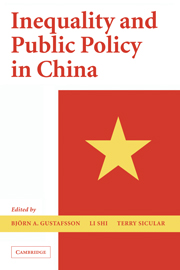Book contents
- Frontmatter
- Contents
- List of Tables and Figures
- Contributors
- Acknowledgments
- 1 Inequality and Public Policy in China: Issues and Trends
- 2 Income Inequality and Spatial Differences in China, 1988, 1995, and 2002
- 3 Growth and Distribution of Household Income in China between 1995 and 2002
- 4 Explaining Incomes and Inequality in China
- 5 The Distribution of Wealth in China
- 6 Growth, Inequality, and Poverty: A Comparative Study of China's Experience in the Periods before and after the Asian Crisis
- 7 What Has Economic Transition Meant for the Well-Being of the Elderly in China?
- 8 Inequity in Financing China's Health Care
- 9 China's Emerging Urban Wage Structure, 1995–2002
- 10 Unemployment, Earlier Retirement, and Changes in the Gender Income Gap in Urban China, 1995–2002
- 11 What Determines Living Arrangements of the Elderly in Urban China?
- 12 The Impact of Village-Specific Factors on Household Income in Rural China
- 13 The Redistributive Impact of Taxation in Rural China, 1995–2002: An Evaluation of Rural Taxation Reform at the Turn of the Century
- Appendix: The 1995 and 2002 Household Surveys: Sampling Methods and Data Description
- Index
- References
2 - Income Inequality and Spatial Differences in China, 1988, 1995, and 2002
Published online by Cambridge University Press: 25 July 2009
- Frontmatter
- Contents
- List of Tables and Figures
- Contributors
- Acknowledgments
- 1 Inequality and Public Policy in China: Issues and Trends
- 2 Income Inequality and Spatial Differences in China, 1988, 1995, and 2002
- 3 Growth and Distribution of Household Income in China between 1995 and 2002
- 4 Explaining Incomes and Inequality in China
- 5 The Distribution of Wealth in China
- 6 Growth, Inequality, and Poverty: A Comparative Study of China's Experience in the Periods before and after the Asian Crisis
- 7 What Has Economic Transition Meant for the Well-Being of the Elderly in China?
- 8 Inequity in Financing China's Health Care
- 9 China's Emerging Urban Wage Structure, 1995–2002
- 10 Unemployment, Earlier Retirement, and Changes in the Gender Income Gap in Urban China, 1995–2002
- 11 What Determines Living Arrangements of the Elderly in Urban China?
- 12 The Impact of Village-Specific Factors on Household Income in Rural China
- 13 The Redistributive Impact of Taxation in Rural China, 1995–2002: An Evaluation of Rural Taxation Reform at the Turn of the Century
- Appendix: The 1995 and 2002 Household Surveys: Sampling Methods and Data Description
- Index
- References
Summary
Introduction
Since the introduction of reforms first in rural areas in the late 1970s and then in urban areas at the beginning of the 1980s, China has moved rapidly toward a market economy. The policy of opening up and marketization has speeded China's economic growth, which was extremely rapid during the 1990s. Growth has been accompanied by China's transformation from a predominantly agrarian economy to an industrial and service-based economy, with a marked increase in urbanization.
Long-run historical examples from the West show that often industrialization goes hand in hand with increased inequality in the distribution of household income, although later this trend reverses (see, e.g., Morrisson 2000). More recently the experiences of countries in Eastern Europe and the former Soviet Union show that the transition from a planned to a market economy is a history of increased income disparities (see, e.g., Milanovic 1998). Thus from different perspectives, rising inequality in China during the 1980s and 1990s was not unexpected.
This chapter presents empirical support for the idea that since the mid-1990s the development of overall income inequality in China has entered a new phase. We show that Lorenz curves and summary measures of income inequality for China as a whole indicate a more or less unchanged inequality in the distribution of income between 1995 and 2002. We also show that this is the net outcome of inequality-increasing and inequality-reducing forces. Urban-rural inequality continued to increase as a proportion of total inequality as it had from 1988 to 1995.
- Type
- Chapter
- Information
- Inequality and Public Policy in China , pp. 35 - 60Publisher: Cambridge University PressPrint publication year: 2008
References
- 12
- Cited by



